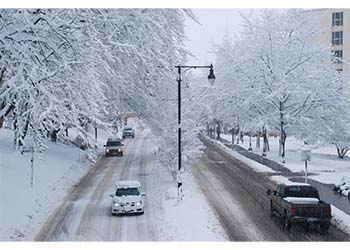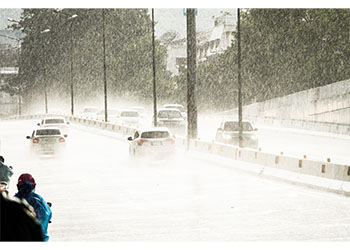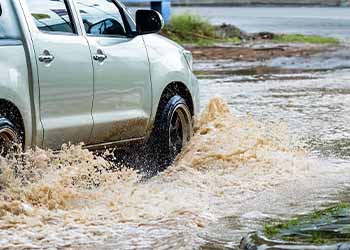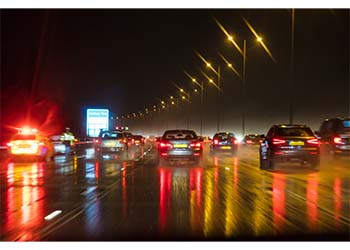
Winter Driving Guide 101
By Soraya Pathmanandam,
22 October 2024, 15 min read
Winter driving presents unique challenges. We have put together a guide to help you get through winter weather conditions. In our guide, you’ll learn essential safety practices and driving techniques. From understanding how to avoid skidding, what to pack for emergencies and how to ensure your vehicle is winter ready. This guide will provide you with all you need to know to feel confident behind the wheel this winter.
Stay informed
During winter, check forecasts and enable notifications for weather alerts on your phone.
If temperatures are expected to drop below freezing, take proactive measures like placing a cover over your car's windshield. This can help prevent the buildup of ice or snow, saving you time and effort when clearing your car before driving.
Essential winter vehicle inspection
Check your fuel
You should check your fuel level before driving in the winter. Keeping your tank at least half full prevents water in the fuel system from freezing. If your fuel lines are frozen, you can add gas line antifreeze (not regular antifreeze) to help melt the ice that has collected. Similarly, if you can move the car, then park it in a garage or warmer area to help the fuel lines thaw.
Monitoring your fuel level will also ensure you have enough fuel in case of unexpected delays or detours which can add more time to your journey.
Check your car battery
In colder temperatures batteries don’t operate as well. This might make your car difficult (or impossible) to start.
Open the car bonnet and carefully inspect the battery. Be careful not to touch the two terminals at the same time (creating a short circuit) as this can result in an electric shock and damage to the battery.
Many batteries have a charge indicator light which shows if the car battery has charge, needs charging or is due to be replaced.
If the body of the battery is swollen, do not attempt to start the vehicle and arrange for a replacement battery to be fitted.
If the terminals are heavily corroded creating a poor connection between the battery and cables, carefully remove the cables from the battery negative (black) first. Use a battery terminal cleaning brush to remove the corrosion. Reattach the battery cables positive (red) first.
Check your coolant
Check your coolant is at the correct level. Your coolant is responsible for circulating heat from the engine through your heating system. This is vital for the blowers to clear your windscreen.
Low coolant levels can allow the inside of the coolant pipes to freeze which can lead to leaks or air entering the system.
To check your coolant levels:
- If you have used the car recently, allow time for the engine to cool to avoid getting burnt.
- Check the fluid level in the coolant expansion tank which is marked on the side. The level should be between the “Min” and “Max” marks or at the “Full” line
- If the coolant level is low, top up with antifreeze, which will be a ready mix or a concentrate which will require diluting. Pour it into the expansion tank until it sits between the “min” and “max” or reaches the “Full” line.
Check your wipers and screenwash
If you are planning on driving in winter, it is important to ensure that your wipers are working and that the screenwash is topped up before you leave home.
Inspect your wipers and check for signs of any damage. Make sure they clean the windscreen properly without making squeaking noises (which indicates wear on the blades) or leaving streaks which might impair your visibility.
If your wipers don’t clean the windscreen properly, or there are signs of excess wear on the blades, it might be time for new blades which can be found at your local car parts shop or online.
Windscreen wash needs to be winter formulated to prevent it freezing in the reservoir if the temperature drops too cold. Winter formula also stops rain or snow from freezing on your windscreen as you’re driving, maintaining visibility, and preventing damage to wiper blades.
To check your windscreen wash level:
- Open the windscreen wash fluid reservoir and visually check if it’s near full
- Top off the fluid if it’s low, using washer fluid that’s rated for winter use
Check your tyres
Check your tyres for wear and tear before setting off during poor winter weather. Tyres should be in good condition and the tread depth must be at least 1.6mm by legal standards.
Check your tread wear indicator which is a ribbed bar labelled “TWI” on the side of your tyres.
If the tread is level with the ribbed bar, then your tyres need to be replaced.
You can also use a tread gauge. To measure the depth, place the gauge on the surface of the tread ensuring that the measuring probe is centred between the tread blocks, which are the raised parts of the tread. Lift the gauge off the tyre and look at the reading comparing it to the legal standard.
Check your headlights
You should check that your lights are bright enough in low visibility during winter conditions. You can check the brightness of your headlights by turning them on, check the strength of the beam using a reflective surface or having someone tell you whether they are working properly or not. If they are not producing a strong, dipped beam then it is best to get them replaced.
Also check for any dirt build-up on the protective glass of the headlights and clean it off using any soft cloth and soapy water.
Driving techniques
Driving in Snow and Ice

Use high gears
Use second gear to move off, as it decreases the possibility of wheel spin and helps your vehicle drive on slippery surfaces more effectively.
Gradually accelerate using low engine revs. Shift to higher gears after initial move off.
Adjust your speed
Snow and ice paired with speed can lead to accidents. It is safer to drive at a reduced speed which allows you enough time to react to other drivers or changes in road conditions.
Drive on fresh snow where possible
You should avoid driving over tyre tracks, as compact snow will be icier.
Stick to the areas of the road with fresh snow because it provides more traction.
If you can, steer your vehicle towards areas of fresh snow, which can help maintain grip on your tyres and prevent skidding.
Take care when driving uphill, downhill, and around corners in snow and ice
Cornering
When driving around a corner, reduce your speed as you approach to allow you enough time to assess what is ahead.
It is important to brake gently as you approach the corner, and not to brake as you turn the steering wheel.
Accelerate gently again once you are around the corner.
Uphill
When approaching a hill, slow down to give yourself time to read the road. If there is slow moving traffic climbing the hill already, it may be best to hold back and wait until other vehicles have reached the top before attempting to ascend it yourself. This means that if traffic stops on the hill, you’re not left having to try and do a hill start with reduced traction.
Whilst driving uphill, maintain a constant speed. If you do have to climb following other vehicles, then increase your stopping distance to at least two car lengths.
Avoid changing gears whilst climbing the hill, as this may cause you to lose traction.
Downhill
Slow down when approaching a hill to give yourself time to assess the road. If the hill is steep and slippery, select a low gear before you reach the start of the downwards slope.
Again, if there is traffic ahead, it might sometimes better to wait for it to have moved on from the base of the hill before driving down.
If this is not possible, maintain a wider gap between cars to account for increased stopping distance - at least two car lengths.
Use engine braking to slow your decent, do not change gears, and avoid using the footbrake.
If you feel you must brake more, gently apply the footbrake. Braking too hard can lock the wheels and cause a skid or slide.
Do not dip the clutch as you drive downhill. If you do dip the clutch, you will lose the braking effect of the engine and free wheel down the hill. In this situation, you have much less control over the vehicle, and it becomes much harder to recover from a skid or a slide.
Look out for gritters
Gritters spray salt on the road to melt ice during winter. Keep an eye out for their flashing amber lights while driving on icy roads to avoid any collisions.
They can spray salt onto your car causing damages to your windscreen and paintwork, so it is best to keep at least three car lengths away from them.
Maintain the additional distance away from it especially at junctions since the truck’s salt sprayer is powered by the engine, resulting in salt being thrown at your car.
Be patient when following behind a gritter, don’t overtake unless it is safe.
Leave a bigger gap if you really need to overtake.
Be careful when driving behind them as traction is reduced due to the salt being deployed as it drives along the road.
Avoid swerving if a gritter is approaching from the opposite direction.
Beware of black ice
Black ice is hard to detect due to its transparent appearance. This makes it dangerous to drive over as it is difficult to tell the difference between the safe areas of the road and the part covered in black ice.
If you encounter black ice, don’t panic, follow the steps below:
Stay calm - Avoid panicking or acting impulsively.
Ease off the accelerator - Avoid braking to prevent skidding and losing control of your vehicle.
Steer straight - This reduces the chances of sliding.
Switch to a lower gear - This can enhance your control of your vehicle.
If your vehicle skids, steer towards the direction of the skid - Avoid overcorrecting, as this may cause you to lose control of your vehicle.
In vehicles equipped with anti-lock brakes, press the brake pedal firmly.
Be especially cautious when driving on shaded areas of road, underneath bridges, and through tunnels as the temperature is lower making it more prone to black ice.
Easy and smooth use of brakes
In cold conditions, reduced grip on the road makes braking less effective. Braking too heavily or sharply can cause your wheels to lose traction and result in a skid.
To prevent skidding, gradually reduce your speed and change down gears sequentially. This approach allows you to take advantage of the engine’s braking effect.
When you do need to use the foot brake, apply gentle, gradual pressure on the brake pedal.
If you do feel the car is sliding or skidding, do not dip the clutch as you’ll lose the added braking effect of the engine.
Skidding
If you start to skid, it is important to stay calm.
You can recover from skidding by taking your time to adjust to the type of skid.
There are two types of skidding, oversteer and understeer:
Oversteers are due to your rear wheels losing grip. It is important to take your foot off the accelerator and steer into the direction of the skid.
Understeers are due to your front wheels losing traction. You will need to come off the accelerator and reduce your steering so your tyres can regain traction.
Regardless of the type of skid, you should not brake because it will cause your vehicle to spin out.
Driving through Fog

Use your fog lights
It is crucial to use your fog lights when visibility drops below 100 metres, which is approximately the distance of 20 cars..
The controls for your fog lights are usually located on your indicator stalk marked by a fog symbol which has three parallel horizontal lines going through a vertical wavy line, align the symbol with the line on your indicator stalk to switch on your fog lights.
Refer to your owner’s manual to locate the fog light controls for your specific car.
Remember to switch off your fog lights when visibility improves.
Turn off the radio and open the windows
By switching off the radio and opening the windows, you will hear any oncoming cars more easily. This will increase the time you have to react to hazards.
Driving through Heavy Rain

Reduce your speed
Slow down to maintain greater control of your vehicle on wet roads. This will help you avoid hazards. With more time, you’ll be able to react calmly and stop if necessary.
Maximise the stopping distance, allowing for enough time to slow down.
Due to wet conditions, it takes longer to come to a complete stop because tyres have a reduced capacity to grip the road.
Avoid aquaplaning
Aquaplaning occurs when there is a build-up of water between the road and your vehicle, leading to a loss of traction and control.
To reduce your chances of aquaplaning, avoid areas with large volumes of settled water like motorways. Stick to driving in the centre lane or in middle of the road.
Maintain a safe distance by increasing the gap and following slowly behind the cars ahead of you.
If your vehicle starts aquaplaning, gently ease off the accelerator and keep the steering wheel straight. As the car begins to regain control, you can gradually brake to slow down.
Avoid using cruise control
Using cruise control can cause you to lose control of your vehicle if you aquaplane (also known hydroplaning). This is caused by the delayed response of the cruise control which tries to maintain a constant speed and can’t react fast enough.
Use your wipers
When driving through heavy rain using your windshield wipers improve your visibility of the road and other drivers.
Ensure you have your wipers on and moving at a constant speed to help remove water droplets consistently.
Different wiper settings and modes should be used for different types of rain:
Intermittent -also known as ‘Rain sense’, is activated by pushing the wiper lever one position. On most cars, you can adjust the frequency of the sweeps using the adjustment ring. Intermittent mode should be used during light rain or drizzle as the wipers only clear the screen intermittently.
Low, constant - is activated by pushing the wiper lever to the second position. Use this setting during light to moderate rain.
High, constant - is activated by pushing the wiper lever to the third position. Use this setting during heavy rain as it provides faster blade movement to keep the screen clear.
You should turn your wipers off when the rain subsides, and visibility is clear.
Upgrade to ‘aero’ wipers as they as designed to be more effective at removing water from the windscreen at a higher speed. The design enhances the durability and longevity of the blades.
Use your headlights
With heavy rain, visibility may be impacted. ByHighway regulations, you must use your dipped beams if visibility is less than 100m.
Driving through Floods

Don’t drive in water that is moving or more than 4” deep
Driving through deep water can cause numerous problems. The risks include hydro locking, which can result in the car being written off, as well as the potential loss of control of your vehicle resulting in an accident.
Additionally, hidden hazards such as debris, missing manhole covers or potholes may not be visible, causing damage to your tyres and undercarriage.
Water can also enter critical areas of your vehicle, causing damage to electrical systems, including the battery, ignition, starter motor, and alternator.
Drive in the middle of the road
The highest point of the road is typically in the middle and, as a result, the water levels are shallower. If you drive in the middle of the road, you will improve your visibility of the road and other drivers. It is best to avoid the flooded areas near the edge of the road as they are more susceptible to erosion and water settling making it unsafe to drive on.
Test your brakes after going through floods
After you have safely driven through flooded areas, you should pull aside and test your brakes. This is due to floodwater getting into your brakes, reducing the efficiency of the braking system and making it more difficult to stop the vehicle. You can test your brakes by lightly tapping on them, which will also help dry them out. Continue doing this until you feel the brakes biting normally.
If your brakes are not responding properly, you should try to come to a complete stop by stepping off the accelerator, turn on your hazard lights and pulling over safely to the left-hand side of the road.
Driving at Night

Get enough rest
Being sleep deprived can result in impaired concentration, a slower reaction time, poor judgement, and increased risk of accidents.
To ensure your safety, it’s essential to be well-rested . Adequate rest improves your ability to react quickly to icy roads and low visibility, helping you stay alert and make better decisions in difficult winter conditions.
Be mindful of how you use your headlights
While driving at night it is important to be mindful of others with the brightness of your headlights. Ensure you use your dipped beam when approaching oncoming traffic as it may impair their vision and lead to an accident. You must also avoid staring at oncoming headlights as it can be disorienting.
Check if you have dimmable rear-view mirrors in your vehicle, as they provide an added layer of safety while driving at night by reducing glare from traffic behind you.
Dimmable mirrors often have a lever, toggle switch or button.
Test if it is functioning properly by pressing the button, pulling the lever or toggling the switch while looking at the mirror.
Some mirrors may have a sensor that detects light levels. If your mirror has a small sensor on the front or side, then it likely has a self-dimming feature.
Reduce your speed
Driving slower at night gives you more time to react to any hazards that may appear such as pedestrians, crossing animals, or an accident in the road.
Keep your windows and mirrors clean
Driving at night can become more difficult if your windscreen, mirrors, and windows are dirty. You should clean these to remove any debris, dirt or grease. Keep a clean cloth handy in your glovebox to remove any condensation that could build up on your windscreen at night.
Take regular breaks
Driving at night can be tiring, so it is important to take breaks along the way. It is advised to take a break every two hours, especially for long distance journeys. This is to allow you to eat and drink and stretch your legs which will help keep you alert.
What to do if your car won’t start in winter?
If the car struggles to start in winter, it may be that the cold has affected the battery.
Testing your battery can be done using a multimeter. These are available cheaply online or from car parts retailers.
Turn off the car. Set the multimeter to the 20V range (as most car batteries operate at 12 volts) and connect the red probe to the positive terminal marked (+) and the black probe to the negative terminal marked (-).
Read the voltage that displays on the multimeter, if it is:
Between 12.6V and 12.8V, the battery is fully charged.
Between 12.4V and 12.6V, the battery is slightly undercharged
Between 12V and 12.4V, the battery is moderately charged.
Below 12V, the battery is undercharged.
If you have good battery voltage, but your car still won’t start, a breakdown policy with home start will allow you to call out a breakdown technician to assist.
What to do in winter if you break down away from home?
Pull over to the side of the road, turn on your hazards, put a warning triangle out and move yourself to safety.
Wear a high vis (high visibility) jacket so other drivers and assistance providers can see you.
If you are on the motorway, you should try to take the car off the road using the nearest exit or by pulling into a service station.
If there isn’t a hard shoulder or you are on a country road then pull over as far left as possible and leave your wheels turned to the left
Call for help from your breakdown provider.If you need help after a breakdown and have no access to your mobile, you can find the emergency phone on the hard shoulder, located inside bright orange boxes If you cannot see one, there are marker posts with arrows that point to the nearest phone.
Call the police if you are obstructing the road.
Leave your vehicle and move to a spot off the road while you wait for assistance .
Driving in Winter emergency essentials
It is better to be prepared for any situation that may occur while on the road. These are some items that we recommend keeping in your car in case of emergencies:
Ice scraper and de-icer
Torch with batteries or a wind-up torch
In-car phone charger
Spare warm clothes and blankets
Jump leads
Snacks or protein bars
Charged power bank
Tablets for the kids
Packable raincoats or ponchos
Reflective warning triangle and High vis jacket
Tow rope or recovery strap
Empty fuel can
After your trip
When you have returned home, you should check the following:
Clean the vehicle to remove road salt that can cause rust, especially on the undercarriage
Check for any damage – inspect your tyres for punctures or sharp objects that may be lodged in the tread. Test your brakes by lightly tapping them to ensure they are functioning properly. Also, check your windshield wipers to make sure they are wiping effectively without leaving any streaks or making noise, especially after driving through severe winter conditions.